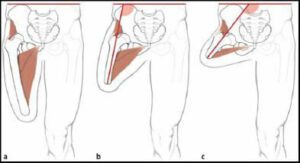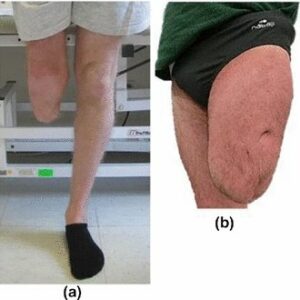If you or a loved one has been diagnosed with an above-knee amputation, it is important to learn as much as you can about the condition and the treatment options available. This blog post will provide you with information about the above-knee amputations, including the causes, symptoms, and treatment options. We hope that this information will help you make informed decisions about your health care.
Contents
Defining Above Knee Amputation

An above-knee amputation is a surgical procedure that involves the removal of the leg above the knee. This type of amputation is also known as a transfemoral amputation.
The surgery is typically performed in cases where the leg has been severely damaged by an injury or disease and is no longer able to function properly. Above-knee amputations are also sometimes necessary in cases where there is a risk of the leg becoming infected.
Symptoms
Various symptoms may occur before or after an above-knee amputation. They are as follows:
- Severe pain in the leg
- Numbness in the leg
- Cramping in the leg muscles
- Weakness in the leg
- Coldness in the leg
- Change in skin color or texture on the leg
- Open wounds or ulcers on the leg
So, these are the symptoms that are seen in patients before or after an above-knee amputation.
Causes
There are various causes of above-knee amputation. They are as follows:
- Severe trauma to the leg, such as from a car accident
- A bad infection in the leg that doesn’t get better with antibiotics
- Gangrene, which is when body tissue dies because of a lack of blood flow
- Peripheral artery disease, which is when plaque buildup in the arteries restricts blood flow to the limbs
Risk Factors
Certain risk factors may increase your chances of needing an above-knee amputation. They are as follows:
- Smoking: Smoking damages blood vessels and reduces blood flow to the limbs, which can lead to gangrene.
- Diabetes: Diabetes can cause nerve damage and poor circulation, both of which can lead to amputation.
- Age: The older you are, the more likely you are to have health conditions that increase your risk of amputation.
- Obesity: Obesity increases your risk of diabetes, high blood pressure, and high cholesterol, all of which can lead to amputation.
- High Blood pressure: High blood pressure can damage blood vessels and reduce blood flow to the limbs.
- Previous Amputation: If you’ve had an amputation before, you’re at a higher risk of needing another one
Complications
Various complications can occur after an above-knee amputation. They are as follows:
- Infection: Infection is a common complication after any surgery. It’s important to keep the surgical site clean and dry to reduce your risk.
- Bleeding: Bleeding is a common complication after any surgery. You may need a blood transfusion if you lose a lot of blood.
- Blood clots: Blood clots can form in the leg after surgery. This can be dangerous if the clot breaks loose and travels to the lungs.
- Phantom limb pain: Phantom limb pain is a sensation that the amputated limb is still there. It’s usually caused by nerve damage.
- Stump sore: A stump sore is a wound on the residual limb. It can be painful and difficult to heal.
- Chronic pain: Chronic pain is long-term pain that can last for months or even years. It can be caused by nerve damage or other factors.
Treatment Options

There are various treatment options for above-knee amputation. The most common treatment is surgery. Other treatments include prostheses, physiotherapy, and occupational therapy.
Surgery
The most common treatment for above-knee amputation is surgery. Surgery aims to remove the diseased or damaged part of the limb and to close the wound. The type of surgery depends on the cause of the amputation.
Prosthesis
A prosthesis is an artificial limb that can be used to replace a missing limb. Prostheses are available for both upper and lower limbs. They can be made from different materials, such as plastic, metal, or composite materials.
Physiotherapy
Physical therapy can help to improve strength, flexibility, and range of motion.
Physiotherapy can help to improve the function of the remaining limb and to reduce pain. It can also help to prevent or delay the onset of muscle weakness and joint stiffness. For example, physiotherapy may involve:
- stretching and strengthening exercises
- massage
- electrical stimulation
- heat or cold therapy
- acupuncture.
Sometimes a prosthesis (artificial limb) can be fitted to help with function. A physiotherapist can assess whether this is appropriate and if so, will help to fit the prosthesis and provide training in its use.
Occupational therapy
Occupational therapy can help to improve the ability to perform daily activities. It can also help to reduce the risk of falls and injuries. For example, an occupational therapist may recommend using a wheelchair or scooter to get around. They may also suggest using special equipment to help with activities such as bathing, dressing, and eating.
Prevention
There are various things you can do to help prevent the need for an above-knee amputation. They are as follows:
- Quit smoking: Smoking increases your risk of infection and slows healing.
- Eat a healthy diet: Eating a healthy diet helps your body heal after surgery.
- Control diabetes: Diabetic patients can help prevent amputation by keeping their blood sugar under control.
- Exercise: Exercise helps improve circulation and can help prevent diabetes and other conditions that lead to amputation.
- Wear proper footwear: Wearing properly fitting shoes helps prevent foot ulcers, which can lead to amputation.
- See your doctor regularly: Seeing your doctor regularly can help catch problems early before they lead to amputation.
- Manage high blood pressure: High blood pressure can damage blood vessels and lead to amputation.
- Keep the amputated limb clean and dry: This helps prevent infection.
- Follow your surgeon’s instructions: This helps ensure a successful surgery and recovery.
These are some prevention tips that should be considered.
How Can You Recover From the Above Knee Amputation?
Recovery from an above-knee amputation can be a long and difficult process. In the immediate aftermath of the surgery, patients will need to stay in the hospital for several days to recover from the procedure.
Once discharged from the hospital, patients will need to undergo extensive rehabilitation to learn how to walk again. This process can take several months, and patients will need to be patient and diligent in their rehabilitation to make a successful recovery.
In the long term, patients who have undergone an above-knee amputation will need to use a prosthetic leg to walk. This can take some time to get used to, but with time and practice, most patients can use their prosthetic leg effectively.
If you have undergone an above-knee amputation, it is important to follow your doctor’s instructions carefully to ensure a successful recovery. With patience and perseverance, you can make a full recovery from this surgery and regain your ability to walk.
How long is recovery from above-knee amputation?
Most people who undergo above-knee amputation can expect to spend several weeks in the hospital. The length of your stay will depend on factors such as your overall health, the severity of your injury, and how well you can tolerate the surgery and rehabilitation process. Once you are discharged from the hospital, you will likely need to undergo several months of physical therapy to regain the full function of your limb.
Some people may never regain full function and will require lifelong assistance with activities such as walking and climbing stairs. Others may be able to return to their previous level of activity with the use of a prosthetic device. In general, the younger and healthier you are, the better your chances of achieving a successful outcome.
If you have any questions or concerns about your recovery, be sure to discuss them with your doctor.
The average healing time for a residual limb is 4 to 8 weeks, but some patients may take longer. Physical rehabilitation usually starts within 48 hours of surgery and can last up to a year.
Conclusion
It may be concluded that above-knee amputation is a serious injury that can result in significant complications and even death. It is important to seek medical attention immediately if you think you may have sustained this type of injury. Above-knee amputations can be costly, both in terms of medical bills and lost productivity. In some cases, people may be able to return to work and live relatively normal lives after an amputation, but in others, the amputation may result in a permanent disability. Talk to a doctor about your specific case and what you can expect in terms of long-term prognosis.
Physical Therapy help patients recover from pain. If you’re experiencing Back pain, Shoulder pain, Knee pain, Neck pain, Elbow pain, Hip pain, or Arthritis pain, a physical therapist at MantraCare can help: Book a physiotherapy session.


